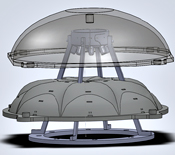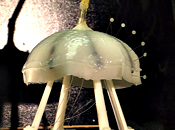The researchers at Virginia Tech Carilion Research Institute (VTC Research Institute) have sandwiched together a couple of chips, each with a hole (window) in the middle giving themselves a peek into biological processes as they occur, they hope. Here’s a more technical explanation from the Dec. 20, 2012 news release on EurekAlert,
Investigators at the Virginia Tech Carilion Research Institute have invented a way to directly image biological structures at their most fundamental level and in their natural habitats. The technique is a major advancement toward the ultimate goal of imaging biological processes in action at the atomic level.
…
The technique involves taking two silicon-nitride microchips with windows etched in their centers and pressing them together until only a 150-nanometer space between them remains. The researchers then fill this pocket with a liquid resembling the natural environment of the biological structure to be imaged, creating a microfluidic chamber.
Then, because free-floating structures yield images with poor resolution, the researchers coat the microchip’s interior surface with a layer of natural biological tethers, such as antibodies, which naturally grab onto a virus and hold it in place.
The lead researcher describes the difference between the usual imaging techniques and their newly developed technique (from the EurekAlert news release),
“It’s sort of like the difference between seeing Han Solo frozen in carbonite and watching him walk around blasting stormtroopers,” said Deborah Kelly, an assistant professor at the VTC Research Institute and a lead author on the paper describing the first successful test of the new technique. “Seeing viruses, for example, in action in their natural environment is invaluable.”
Ken Kingery’s Dec. ??, 2012 Virginia Tech Carilion Research Institute article, which originated the news release, describes the specific virus the researchers used the ‘window’ to spy on,
Rotavirus is the most common cause of severe diarrhea among infants and children. By the age of five, nearly every child in the world has been infected at least once. And although the disease tends to be easily managed in the developed world, in developing countries rotavirus kills more than 450,000 children a year.
At the second step in the pathogen’s life cycle, rotavirus sheds its outer layer, which allows it to enter a cell, and becomes what is called a double-layered particle. Once its second layer is exposed, the virus is ready to begin using the cell’s own infrastructure to produce more viruses. It was the viral structure at this stage that the researchers imaged in the new study.
Kelly and McDonald [Sarah McDonald, an assistant professor at the VTC Research Institute] coated the interior window of the microchip with antibodies to the virus. The antibodies, in turn, latched onto the rotaviruses that were injected into the microfluidic chamber and held them in place. The researchers then used a transmission electron microscope to image the prepared slide.
The technique worked perfectly.
The experiment gave results that resembled those achieved using traditional freezing methods to prepare rotavirus for electron microscopy, proving that the new technique can deliver accurate results. “It’s the first time scientists have imaged anything on this scale in liquid,” said Kelly.
There’s more to work to be done of course as the researchers refine the technique and try to ‘spy’ on more of the processes. In the meantime, the paper about this latest imaging research will be published in print in 2013 or it can be viewed online now (this is a open access article in a journal published by the Royal Society of Chemistry [RSC], you will need to sign up but this too is free),
Visualizing viral assemblies in a nanoscale biosphere
Brian L. Gilmore , Shannon P. Showalter , Madeline J. Dukes , Justin R. Tanner , Andrew C. Demmert , Sarah M. McDonald and Deborah F. KellyLab Chip, 2013,13, 216-219
DOI: 10.1039/C2LC41008G Received 15 Jun 2012, Accepted 13 Nov 2012 First published on the web 19 Nov 201

